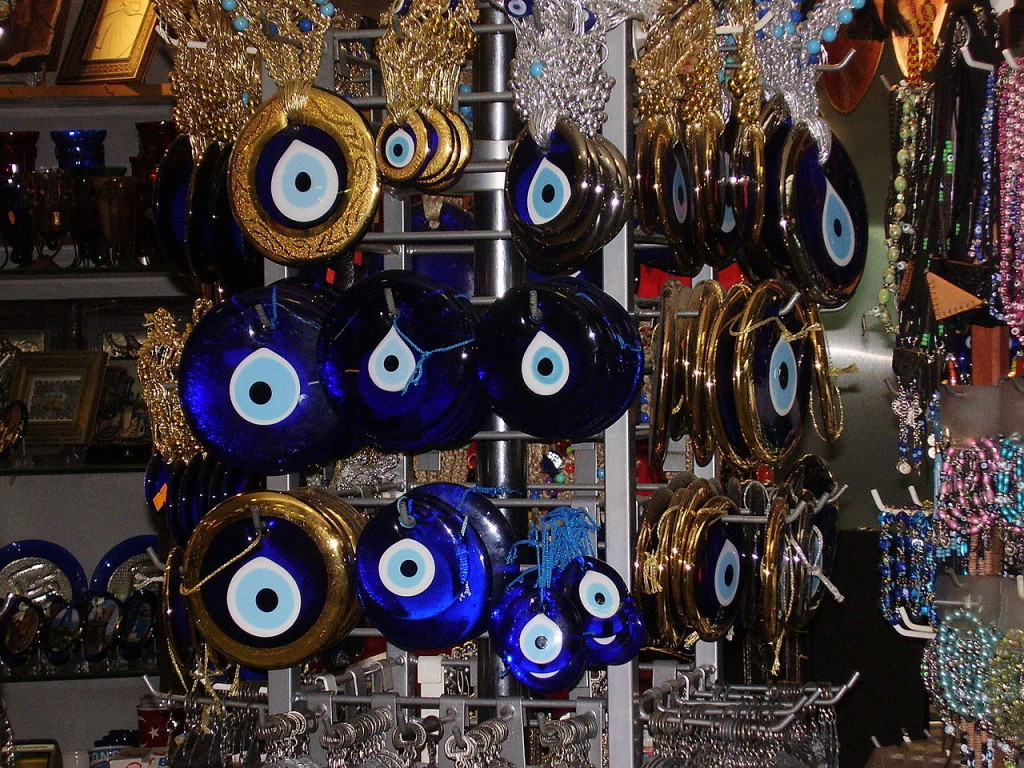The Evil Eye is a look given to inflict harm, suffering, or some form of bad luck on those upon whom it is cast, either out of jealousy or malice. The superstition of the evil eye holds that the malicious look is powerful enough to bring about actual disaster for the unfortunate recipient of the glare.
The blue eye charm, known as μάτι (mati), “eye”, is worn as a means of reflecting harm cast by the Evil Eye. The eye motif is known to have been used in Greece dating back to at least the 6th century BC, when the eye commonly appeared on drinking vessels.

In Greece, the Evil Eye is cast away through the process of xematiasma (ξεμάτιασμα), whereby the “healer” silently recites a secret prayer passed over from an older relative of the opposite sex, usually a grandparent. Such prayers are revealed only under specific circumstances, for according to superstition those who reveal them indiscriminately lose their ability to cast off the Evil Eye. There are several regional versions of the prayer in question, a common one being: “Holy Virgin, Our Lady, if [insert name of the victim] is suffering of the Evil Eye, release him/her of it.” Evil repeated three times. According to custom, if one is indeed afflicted with the Evil Eye, both victim and “healer” then start yawning profusely. The “healer” then performs the sign of the cross three times, and emits spitting-like sounds in the air three times. A very similar ritual can be found in neighbouring Bulgaria.
Another “test” used to check if the Evil Eye was cast is that of the oil: under normal conditions, olive oil floats in water, as it is less dense than water. The test of the oil is performed by placing one drop of olive oil in a glass of water, typically holy water. If the drop floats, the test concludes there is no Evil Eye involved. If the drop sinks, then it is asserted that the Evil Eye is cast indeed. Another form of the test is to place two drops of olive oil into a glass of water. If the drops remain separated, the test concludes there is no Evil Eye, but if they merge, there is. There is also a third form where in a plate full of water the “healer” places three or nine drops of oil. If the oil drops become larger and eventually dissolve in the water there is Evil Eye. If the drops remain separated from water in a form of a small circle there isn’t. The first drops are the most important and the number of drops that dissolve in water indicate the strength of the Evil Eye.
There is another form of the “test” where the “healer” sets on fire using as a matchstick a clove. which is then thrown in water. If the clove “explodes” upon touching water the Evil Eye was cast. If it burns out silently it wasn’t.
All of the above methods are usually performed by an old lady, who is known for her healing, or a grandparent.
The Greek priests accepted the traditional belief in the Evil Eye, but attributed it to the Devil and envy. In Greek theology, the Evil Eye or vaskania (βασκανία) is considered harmful for the one whose envy inflicts it on others as well as for the sufferer. The Greek Church has an ancient prayer against vaskania from the Megan Hieron Synekdemon (Μέγαν Ιερόν Συνέκδημον) book of prayers.
